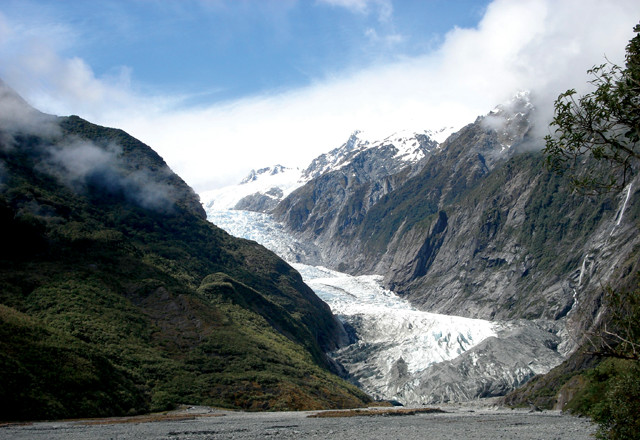
by Timothy Oleson Wednesday, April 19, 2017

Bucking the global trend of glacial retreat, Franz Josef Glacier in New Zealand's Southern Alps advanced for much of the period between 1983 and 2008. Credit: Wendy Mann, CC BY 2.0.
From Antarctica to the Arctic; from polar caps, permafrost and glaciers to ocean-rafted sea ice; and from burly bears to cold-loving microbes, fascinating science is found in every nook and crevasse of Earth’s cryosphere, and new findings are announced often. Here are a few of the latest updates.
Two new studies describe the differing fates of glaciers on opposite sides of the planet in recent years. In the first study, Romain Millan, of the University of California, Irvine, and colleagues mapped the ice velocity and thickness of glaciers in Canada’s Queen Elizabeth Islands, which account for about 14 percent of global glacier area outside of the Greenland and Antarctic ice sheets. The researchers reported in Environmental Research Letters that, from 1991 to 2005, roughly 6.3 billion tons of ice were lost per year, about half via iceberg calving and half through melting of surface ice. But between 2005 and 2015, annual ice loss was dramatically higher: about 33 billion tons, with 90 percent of that coming by way of surface melting.
In the second study, published in Nature Communications, Andrew Mackintosh, of Victoria University of Wellington in New Zealand, and colleagues report on regional climatic trends controlling glacial behavior in the country’s Southern Alps. Contrary to the global trend, the termini of 58 glaciers advanced at some point between 1983 and 2008, with 12 advancing for five or more consecutive years; the Fox and Franz Josef glaciers each advanced for almost the entire 25-year period. Previous work had indicated that such glacial advances might be driven mainly by local increases in precipitation. But based on climate and glacier mass balance modeling, Mackintosh’s team found instead that temporary drops in air temperature “associated with anomalous southerly winds and low sea-surface temperature in the Tasman Sea region” were the more likely cause for New Zealand’s advancing glaciers.
Species of microscopic diatoms — adapted to a multitude of different oceanic conditions — make up large proportions of marine phytoplankton communities globally, serving as the base of food webs and sequestering carbon in their shells. In a new study in Nature of a major Southern Ocean diatom called Fragilariopsis cylindrus, researchers have identified genomic features that might help it thrive in frigid seawater, where light and nutrients are often in short supply. They found that roughly a quarter of the F. cylindrus genome comprised mutated versions, or alleles, of genes shared with diatom species from temperate ocean waters, where dissolved iron, a key nutrient, is more abundant. These “divergent alleles may be involved in adaptation to environmental fluctuations in the Southern Ocean,” wrote Thomas Mock of the University of East Anglia in England and colleagues. The team also found genomic features that appear to be unique to F. cylindrus, including genes responsible for making proteins that harvest light to create chlorophyll, proteins that bind ice, and proteins that bind zinc, which is relatively enriched in the Southern Ocean..
Deep waters off part of Antarctica are freshening faster than they were just a decade ago, according to a new study in Science Advances. In 2016, scientists collected samples of Antarctic Bottom Water (AABW) along an ocean transect from the Antarctic coast into the Indian Ocean. Samples collected in 1994 and 2007 along the same transect showed that AABW was freshening and warming. Based on the 2016 samples, Viviane Menezes of Woods Hole Oceanographic Institution (WHOI) and colleagues found that AABW warming had continued, but at a slower pace. However, they reported, the water freshened at four times the rate it did from 1994 to 2007, possibly a result of increased glacial melting following a massive iceberg-glacier collision and calving event in 2010. AABW, a major driver of global oceanic circulation and chemistry, forms when relatively cold, salty and dense seawater off the Antarctic coast sinks to the bottom of the ocean. “The fresher and warmer the water is, the less dense it will be,” said co-author Alison Macdonald, also of WHOI, in a statement. “If these waters no longer sink, it could have far-reaching effects for global ocean circulation patterns.”
© 2008-2021. All rights reserved. Any copying, redistribution or retransmission of any of the contents of this service without the expressed written permission of the American Geosciences Institute is expressly prohibited. Click here for all copyright requests.